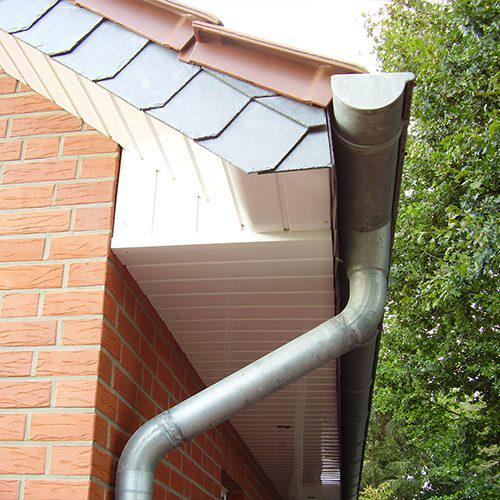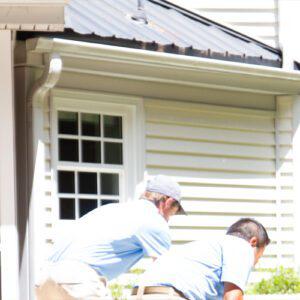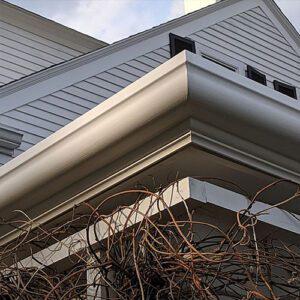At the most basic level, rain gutters are troughs that reroute water away from one place to another. The concept isn’t new—the earliest record of a gutter system dates back to 2600 BCE- and the basic concepts of how gutters work hasn’t changed. Although, it has evolved to live above ground as well as below. And, it’s more complicated than digging a ditch and lining it with stone or brick.
The Anatomy of Gutter Systems
As civilization advanced, so did our need to maintain our living spaces. While your gutter system isn’t likely to feature gargoyles like the Notre Dame cathedral pictured to the right, it’s still the same function. Here are the necessary parts of most gutter systems today:
- Hanging Hardware. This is what secures a gutter system to the fascia and soffits of a home. Time, weather, and materials can make these connections looser, which can impact your gutter system’s ability to reroute water. Hanging hardware also includes the ferrule, which is a shaft that protects the screw used to anchor gutters to the wall, and the pipe cleats, which secure the downspout.
- Gutter Trough. Typically when we think about gutters, this is the part that comes to mind rather than the whole system. This part of your gutters, as well as the downspout, may be made out of different materials.
- The Downspout. While a gutter system can still somewhat function without this, for most architecture, it’s a necessity. Downspouts ensure that water doesn’t spill out onto sidewalks or settle at the foundation of a home by routing it to a specific place on the ground.
- End Caps. Fitted to the end of a gutter length, end caps seal off the gutter to prevent water spillage.
- Mitered Corners. This is the corner piece of the gutter used to connect two portions of the gutter system around corners.
Optional, but extremely useful features of a gutter system:
- Gutter Guards. For homes where there is a lot of flora and fauna, gutter guards are an invaluable addition to your gutter system. They help ensure that plants, seeds, leaves, and animals won't clog up your system.
- Downspout Extension. This is useful for properties where even with a downspout, water will still end up settling where you don’t want it. Extenders can route it to a specific location, like a street drain or ornamental flower beds.
What Are Gutters Made Of?
Gutter materials tend to change and adapt to the latest and most durable materials. Your property’s needs, personal taste, location, and price point are all factors to consider when looking at gutter options and what material works best for your property. Here are the materials that are used for gutters available today.
Benefits & Drawbacks of Each Gutter Type |
||||||
| Vinyl | Steel | Aluminum | Zinc | Copper | Seamless Aluminum | |
| Lightweight | ||||||
| Easy to install | ||||||
| Many color options | ||||||
| Won’t rust | ||||||
| Very durable | ||||||
| Long-lasting | ||||||
| Beautiful aesthetic | n/a | n/a | n/a | |||
| Reduces the chances of leaks | ||||||
| Custom made for the home | ||||||
Selecting the Right Type of Gutter
The purpose of rain gutters is to reroute the flow of water but, where you are will determine how effectively certain types of gutter systems can do that. Here are the three types of gutter systems that homeowners will encounter when shopping for a system or installer.
 RosarioVanTulpe – CC BY-SA 3.0
RosarioVanTulpe – CC BY-SA 3.0
Half-Round Gutters
Shaped like a tube cut in half, this type of gutter tends to be less efficient compared to newer styles and types, but for neighborhoods with historic homes, they may be required to maintain the look and feel of the area. Fortunately, you can put gutter guards on half-round gutters, which should reduce the need for frequent gutter cleaning.

K-Style Gutters
A popular choice since the 1950’s, this gutter type is fashioned to look like crown molding, making them an aesthetically pleasing addition to the home. And, due to their shape, they typically carry more water than half-round gutters. The downside to this particular type of gutter is that debris can accumulate in the corners, which can make it somewhat more difficult to clean. Installing gutter guards, however, can help with this.
 Fibergutter – CC BY-SA 4.0
Fibergutter – CC BY-SA 4.0
Fascia Gutters
This gutter type is custom-built for each home or business. Because of this, there are fewer seams and less risk of rust or leakage. Aesthetically, these gutter systems tend to look better, although they have to be professionally installed and are typically significantly more expensive than other gutter systems and DIY installation projects.
Damage Caused by a Faulty Gutter System
When you have clogged gutters, your home has no way of draining water after heavy rain. This is especially taxing to your home if you live in the southeast in cities like Nashville, Lake Norman, or Lake Wylie, which can experience intense summer storms. If a clogged gutter system is left unattended for long enough, the damage to your property can be substantial and can include:
- Roof and wall damage (both interior and exterior)
- Damage to the foundation and basement
- Accumulation of allergens
- Ruined and damaged landscaping
The build-up of water can seep into your home or building’s structure, resulting in water damage. The chart below illustrates the costs of water damage to your roof and walls alone and not the other costs associated with damage from clogged gutters.
Cost Breakdown of Water Damage |
|
| Replacements | Cost |
| Roof (1,000 sq ft) | $4,000 to $5,500 |
| Gutter System | $1,000 to $5,000 |
| Lighting | $150 to $350 |
| Soffit & Fascia | $2,500 (average) |
| Total | $7,650 to $13,350 |
| Repairs | Cost |
| Ceiling repair | $325 to $1,100 |
| Drywall repair | $275 to $785 |
| Electrical | $1,500+ |
| Total | $2,100 to $3,385 |
Price estimates are based on the average market value of materials and labor for the average 1,000 sq. ft. home with a total roof size of about 1,200 sq. ft.
Professional Gutter Cleaning for Your Gutters
Hiring professional gutter cleaning services is a cost-effective and smart way to keep your home in tip-top shape. While you can clean your gutters yourself, we recommend hiring a professional service for convenience and to avoid any damage to your property or injury to yourself. Start reaching out to a few seasoned professionals to make sure you're spending your money with a company that gets the job done correctly. Now that you know how much of a silent danger clogged gutters are to your home, take a look at how we can help and contact us for a free price quote today!
Frequently asked questions about what gutters do
How do gutters work? Read our frequently asked questions for that answer and even more.
What is the point of a gutter?
Gutters route water from one area to another. There are numerous reasons for this, including safety to avoid flooding, or maintaining the integrity of a structure.
Is it OK to not have gutters?
There are some situations where gutters aren’t necessary at all. For buildings that sit on hills, gravity may assist in routing water away from the home. Additionally, gutters may not be necessary for particularly arid climates that see little or no rain.
Do I need gutters around my entire house?
It really depends on the home. Some roof types and structures can have gutters on only part of the house rather than the entire roof. It’s best to consult with a professional to determine if you need gutters and if so, if they are needed around the whole house.
How do gutters protect your home?
Gutters protect your home by preventing water from sitting on the surrounding ground and foundation. This helps prevent damage to your home’s structure and avoids costly repairs and renovations.
